Looking for information on how long foam jacking lasts? If so, don’t hit that back button because you’ve landed on the right page. In this article, we’re going to talk about what foam jacking is, how it’s performed, how long it lasts, why concrete slabs like driveways and sidewalks become uneven, and more.
What Is Foam Jacking?
Foam jacking, also known as polyjacking, slabjacking, or polyurethane foam injection, is used to repair sunken or uneven concrete surfaces. It’s a cost-effective and non-invasive alternative to complete concrete replacement.
The process involves injecting a polyurethane foam mixture underneath the sunken concrete, which then expands and hardens, lifting the concrete back to its original level. We’ll talk more about the exact procedure in just a bit.
Foam jacking is versatile and can be used to repair a range of concrete surfaces, including driveways, sidewalks, patios, pool decks, and even interior slabs. The foam mixture is specially formulated to bond strongly with the existing concrete, ensuring a long-lasting and durable repair.
Benefits Of Foam Jacking
Foam jacking is quick
One of the primary advantages of foam jacking is its speed and efficiency. The process can often be completed in just a few hours, with minimal disruption, and the area can be used immediately after the work is done. Unlike traditional concrete replacement, there is no need for heavy equipment or excavation work, which can be both time-consuming and expensive.
Foam jacking is environmentally friendly
Another benefit of foam jacking is its environmental friendliness. The foam mixture used in the process is non-toxic and produces no harmful emissions, making it a safe option. Additionally, because the process requires less material and has less waste than traditional concrete replacement, it’s considered a more sustainable choice.
The foam jacking material is lightweight
Foam jacking can lift and level concrete without adding more weight to the soil. Mudjacking, an older technique, involves injecting a mixture of water, cement, and soil underneath sunken concrete to lift it back into place. This places additional weight on the soil, leading to further soil settlement problems. Foam jacking also offers better control over the lift, as the material can be injected precisely where it’s needed, allowing for a more accurate and permanent repair.
Foam jacking doesn’t make a big mess
Unlike traditional concrete repair methods, foam reduces the mess and debris created during the process, making it a cleaner and more eco-friendly option.
Foam jacking costs less than replacing the concrete slab
Another benefit of foam jacking is its affordability. Compared to digging up and replacing the slab, it’s inexpensive. As a result, foam jacking is a cost-effective option for homeowners and businesses looking to repair their concrete surfaces without breaking the bank.
Why Do Concrete Slabs Like Sidewalks And Driveways Become Uneven?
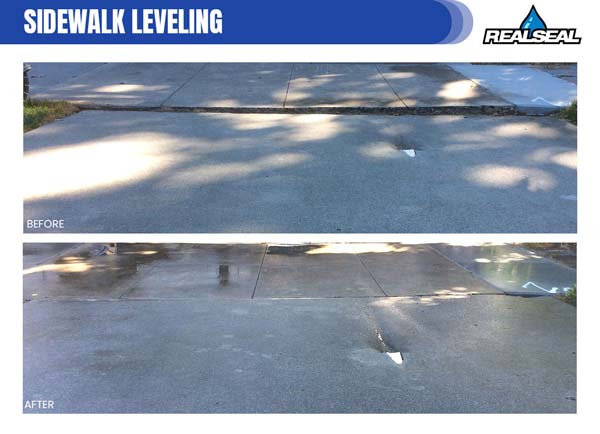
Concrete slabs, like sidewalks and driveways, are susceptible to becoming uneven for various reasons. These include the following:
- One of the most common factors is the natural settling of the soil over time. As the soil beneath the concrete slab shifts and settles, the weight distribution may become imbalanced, leading to unevenness.
- Additionally, changes in moisture levels can cause clay-rich soil to expand or contract, further contributing to the unevenness of the concrete slab.
- Concrete slabs can also become uneven due to poor installation practices. If the underlying base for the slab isn’t adequately compacted and graded, it can result in an unstable foundation which may eventually lead to settling and unevenness.
- If the concrete mix isn’t properly prepared, it can result in a weak slab prone to cracking and unevenness.
- Heavy usage over time can also contribute to the formation of cracks and unevenness on concrete slabs. Vehicles, foot traffic, and extreme temperatures can all cause wear and tear on the concrete, leading to uneven surfaces.
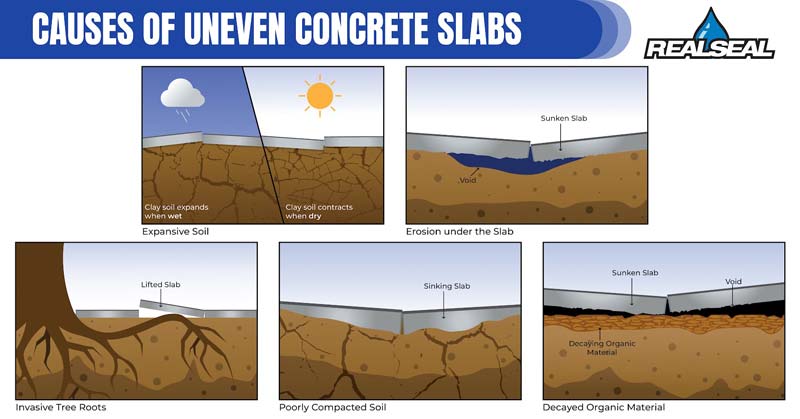
Proper construction techniques and regular maintenance practices will help prevent unevenness.
How Does Foam Jacking Work To Level An Uneven Sidewalk Or Driveway?
The foam material used in this process is a lightweight polyurethane foam that expands upon injection, filling all voids under the slab. As the foam expands, it lifts the uneven concrete surface until the desired level is achieved. The foam material is designed to be strong, durable, and long-lasting, providing a permanent solution to the problem of uneven concrete surfaces.
Step 1 – Preparation
The area that needs lifting is first cleared of any debris or obstacles.
Step 2 – Drilling Holes
Small, dime-sized holes (spaced apart according to the extent of the area to be lifted) are drilled into the affected slab.
Step 3 – Injecting the Foam
After drilling the holes, the polyurethane foam is injected beneath the concrete slab through the pre-drilled holes using a specialized injection gun that pumps the foam into the voids.
Step 4 – Foam Expansion Lifts the Slab
Once injected into the voids, the polyurethane foam expands and spreads, lifting the concrete slab. The foam also fills the gaps and cavities created by sinking soil, replacing the lost support, and stabilizing the slab.
Step 5 – Patching the Holes
After the foam injection process, the holes drilled in the concrete are filled with cementitious grout, giving the area a clean and finished appearance. Around 15 minutes or so after the repair, the slab is ready for use.
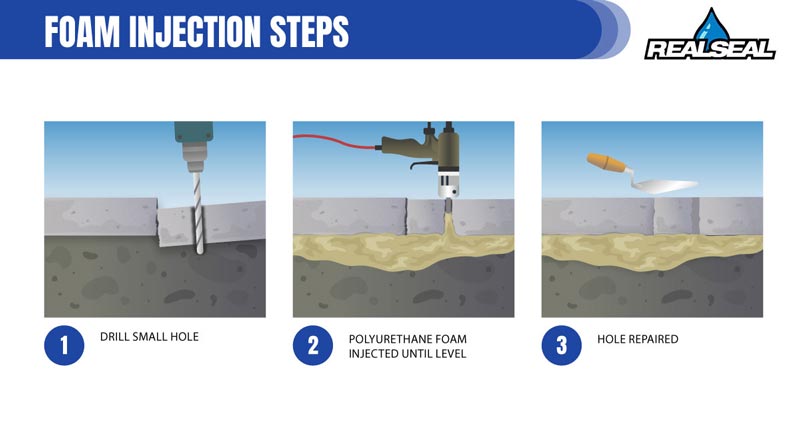
Lifting and leveling an uneven sidewalk using foam jacking can be a game-changer. This process can be done quickly and efficiently, costing a fraction of the price of traditional methods, such as tearing out and replacing the entire slab. It’s also environmentally friendly as the polyurethane foam helps to control soil erosion, making it an excellent choice for eco-conscious homeowners.
How Long Does Foam Jacking Last?
The lifespan of foam jacking can vary depending on various factors, such as the quality of the foam, the environment, the weight and use of the concrete slab, and the contractor’s skill level.
Generally, foam jacking can last up to 10 to 20 years or more before the concrete slab needs to be lifted again. This is because the foam material used in foam jacking is designed to be long-lasting and resistant to degradation and compression. The foam injected under the concrete slab cures and expands, creating a stable base that can support the weight and pressure of the slab for an extended period.
However, it’s essential to note that the lifespan of foam jacking can be affected by weather conditions and soil movement. For instance, harsh weather conditions such as extreme heat, heavy rain, and freezing temperatures can cause the concrete slab to shift and settle. Additionally, soil movement due to changes in moisture levels or earthquakes can also affect the stability and longevity of a foam-jacked concrete slab.
Work with a reputable and experienced contractor who uses high-quality materials and techniques. This will ensure that foam jacking lasts as long as possible.
What About Replacing The Concrete Slab?
When fixing sunken concrete slabs or uneven surfaces, homeowners may need to decide between foam jacking or replacing the concrete slab entirely. Both options have advantages and disadvantages that should be considered before making a decision.
Foam jacking is fast and cost-effective
One of the main benefits of foam jacking is its cost-effectiveness compared to replacing the slab. Foam jacking typically costs 50-75% less than slab replacement, making it an attractive option for those on a tight budget.
Foam jacking is much faster than replacing the concrete slab, as the process can be completed in just a few hours.
Foam jacking is also more eco-friendly, as it does not require breaking up and removing the old slab, reducing the amount of waste generated.
When does a slab need to be replaced?
Replacing a slab is more expensive and time-consuming than foam jacking. However, it may be necessary in some situations, such as when the slab is severely damaged or cracked.
Full slab replacement can take several days or even weeks to complete, disrupting daily routines and causing inconvenience to homeowners.
Additionally, slab replacement requires heavy machinery, which can damage surrounding areas and disrupt the landscape.
The decision between foam jacking and replacing the concrete slab ultimately depends on the situation. Consult a professional contractor to determine the best course of action for your case.
Is Foam Jacking Better Than Mudjacking?
Foam jacking is better than mudjacking for lifting and leveling an uneven concrete slab. Here’s why:
- The holes used to inject the mudjacking slurry under the slab are larger than those used for foam jacking. This affects the aesthetics of the repaired slab. The patched holes are more visible, in other words.
- Another significant advantage of foam jacking is its durability. Unlike mudjacking, which can crack and settle again if the soil beneath it shifts or compresses, polyurethane foam is long-lasting and can withstand heavy loads and foot traffic.
- The foam material won’t erode. The slurry used in mudjacking is susceptible to erosion because it contains soil.
- Foam jacking is also a more precise and efficient solution to leveling concrete. The foam material can be controlled more easily, and the technician can adjust the injection rate based on the extent of the sunken area. This means that only the required amount of foam is injected, reducing waste and cost.
- Foam jacking lasts longer than mudjacking. While foam jacking can last 20 years or longer, mudjacking often only lasts a few years.
- Foam jacking is a faster repair than mudjacking. Most foam jacking jobs take only a few hours, and then the slab is ready for use again. With mudjacking, you’ll need to wait up to 24-72 hours before you can use the slab again.
At The Real Seal, we believe foam jacking is superior to mudjacking for repairing sunken concrete. Its durability, environmental friendliness, precision, and efficiency make it a more reliable and cost-effective option for homeowners and contractors who want a long-term solution to their concrete problems.
How Much Does Foam Jacking Cost?
The cost of foam jacking largely depends on several factors, including the severity and size of the concrete slab damage, the amount of foam needed to fill the voids, and the project’s location. On average, foam jacking costs range from $10 to $25 per square foot.
While foam jacking is more expensive than mudjacking, it’s less expensive (and faster!) than tearing up the uneven slab and pouring a new one.
What About DIY Foam Jacking?
While foam jacking may seem simple, it’s complex and requires the expertise of trained professionals. While some may be tempted to attempt the project themselves to save money, it’s essential to understand why this is not a DIY job.
- Foam jacking requires specialized equipment that isn’t readily available to the average homeowner.
- The science of foam jacking involves a precise injection technique that cannot be improvised. The foam needs to reach the right areas of the slab in the correct quantities to achieve the desired outcome. Any mistakes in the process can result in uneven lifting or damage to the slab.
- Professionals can offer warranties and guarantees for their work, giving homeowners peace of mind that the job has been done correctly. DIY attempts that result in poor outcomes may cost more money in the long run, as additional repairs may be required to fix any mistakes made during the DIY project.
If you’re concerned about an uneven concrete slab on your Chicagoland property, such as a sidewalk, driveway, or patio, contact The Real Seal today to schedule an evaluation and receive a repair estimate.
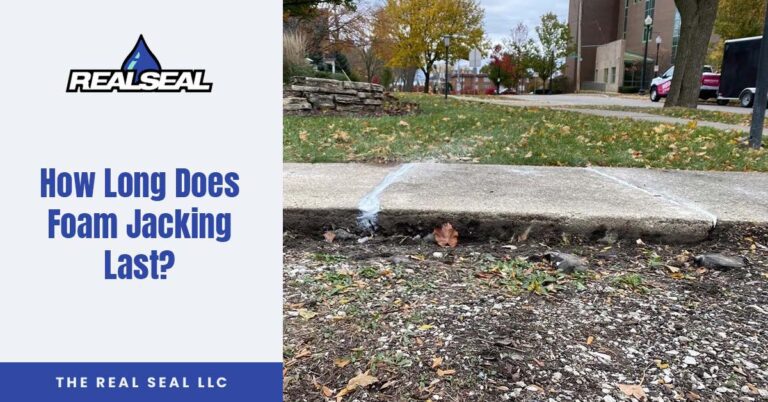
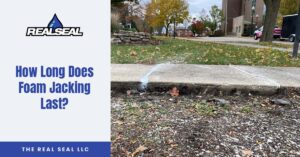





8 Responses
As an AI language model, I don’t have direct access to external content, including specific blogs. Therefore, I cannot view or analyze the content from the link you provided.
However, based on the title “How Long Does Foam Jacking Last?” it seems like an informative blog that addresses the longevity and durability of foam jacking as a concrete repair method
Well this is a first! An AI language model? It is indeed an informative blog about the longevity of Polyjacking for lifting and leveling concrete.
The blog effectively addresses common questions and concerns about the longevity of foam jacking, offering a well-researched and informative perspective on its lifespan.
Thanks so much!
Firstly, I appreciate your effort. Thankyou so much
You’re welcome!
Greetings Austin
I’ve got a circular slab (roughly 10×10)
with row of brick pavers around it. I want to protect and save the existing slab. With our rains we’ve had, the slab has risen. I’m guessing the pavers removed you could repair the sub ground to include the polyform slab Jack process. Could you offer a quote?
Hi Jeff!
Unfortunately with heaving, Polyjacking is not the best solution. Polyjacking works by injecting an expanding foam under the slab, which would only raise it more.
It sounds like you have expanding clay soil. I would recommend installing a French Drain around the slab to help keep the soil more dry. It is possible the slab doesn’t have the required amount of base when built, which also contributes to heaving in these cases.